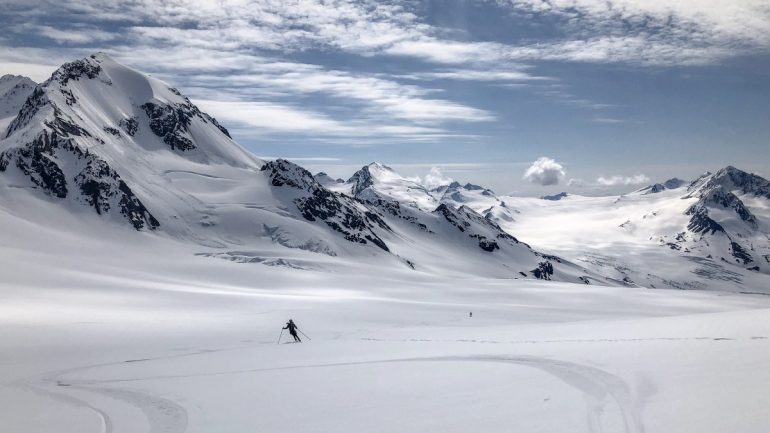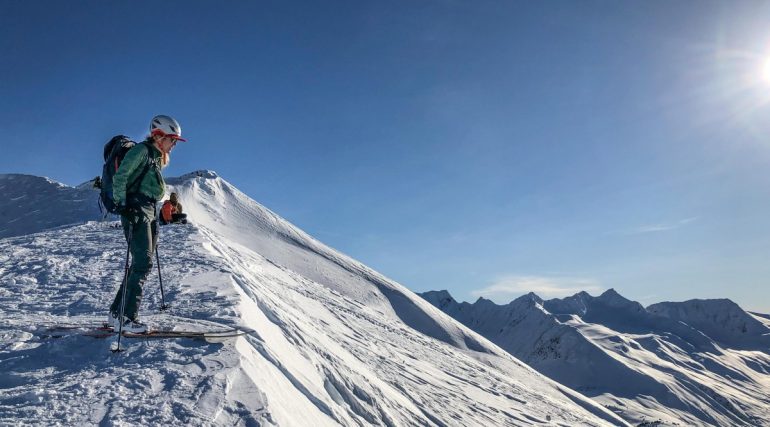
Alex skiing towards the Eagle Glacier during a 40-mile day on race skis in the Chugach Mountains. Photo by Eric Dahl
Stuck on Zoom, yakking about skinny skis
By Emily Sullivan and Alex Lee
When most folks think about skiing in Alaska, their minds conjure up images of spine lines, helicopters and powder billowing over head. Even most hearty full-bearded Alaskans seem to think that 115mm underfoot full metal jacket ammunition is needed to get out in the mountains. In truth, TGR moments are rather rare here. Skiing and riding in Alaska is usually as much about the wilderness experience as it is about the turns, and light gear opens up an incredible amount of terrain, making for great adventures in big mountains.
Much like kimchi, snapchat, and soft shell pants (all trends tend to reach AK behind schedule) Alaskans are late adopters of the increasingly popular skinny ski trend in the backcountry. Skimo gear is almost counter-culture here, as evidenced by ridiculing stares and sass thrown our direction when we take toothpick skis and race packs out into big terrain. Yeah, we might look silly out there in the raddest backcountry terrain on the planet, but we sure have a lot of fun.
Stuck at home, bleary-eyed and jonesing for snow we–WildSnow ‘light-is-right’ correspondent Alex Lee, and Voile Ambassador and fellow AK speed-weenie Emily Sullivan — find ourselves talking about about our shared proclivity for taking skinny sticks into big mountains over Zoom from across town in Anchorage. Being that we are somewhat housebound with insatiable mountain addictions, at least nerding out on ski chat beats watching Tiger King for a second time…
Alex: Hey Emily, I know we both had big plans on little skis this spring. Just because objectives have to be tempered these days, talking about skiing doesn’t…
Emily: Definitely. So, what do we mean by ‘little’ ski anyway? Anything 80mm and under?
Alex: Well hang on a minute – what if I take out 88s on pow day?
Emily: Point taken. There’s a ratio of snow softness to ski width to be considered. Your 88s are little skis on a deep pow day–especially because you ski them with Sytrons and 145 gram bindings. I’m a believer in light skis because I want to ski more than one lap per day. Preferably, like, five or six… or nine in the spring! Whatever ski allows me to tackle maximum vert in a given day is usually what I choose. Sometimes on deep days that means I go light and wide. It’s all a spectrum.
Alex: I agree, I mean even if light gear won’t save your soul, it will save your hip-flexors. Ninety-percent of the day is spent on the up, plus I like pizza and beer. Besides, the days here are darn short most of the winter – more than 7,000 ft vert means moving pretty quick. Light skis open up all sorts of cool options.
One of my favorite tours last year was a one-and-done day. I had a work meeting at noon. The sun rose at 10 a.m., I met Malcolm and Trish at 9 a.m. An hour and forty-five minutes and 3900 feet later, we were on top of Granddaddy peak. I felt like I’d just been run through the laundry, but I even had time to tuck in my shirt before arriving early for the meeting. Kinda makes me wonder why every boreal skier doesn’t drop gear weight- why do you think so many AK folks are reluctant?
Emily: Fear of the unknown. My heavy-metal friends are hesitant because they believe that they can’t ski as fast or as aggressively on little skis. While that might be true, there’s an implication that you need big skis to ski big lines, which you and I both know is false! People are rad — a friend skied the Orient Express on Denali last spring on her BD 76s.
Alex: That’s awesome! Plus, shedding weight opens up distance.
Emily: So true — FKT’s on local long-distance traverses have been slashed dramatically in recent years by folks catching on to the skimo trend. I’ve certainly benefited from adopting the light-is-right mentality: on my first day out on my Voile WSPs (63 underfoot), we did the Turnagain Traverse, skiing all of the popular roadside peaks from Eddie’s to Magnum in a day (Alex’s idea!). We encountered just about every type of snow–I was able to hold my own on the downhills, and my little gear really saved me on the slogs.
Alex: I know that any skis are going to feel heavy once we can head for the hills again, at least little skis will make for an easier reentry. Also, I am starting to think the ‘light is right’ mentality translates to bread-baking (70% hydration), beer drinking (Miller Lite), and neighborhood walks (my dog is 12)…
Emily: Maybe, all I know is that the sooner we flatten the curve, the sooner we’ll have something better to write about…
Dr. Alex Lee lives in Anchorage, Alaska. Alex is a professor at Alaska Pacific University, teaching philosophy and environmental studies. He also works as a sometimes guide, naturalist, writer, and photographer.

